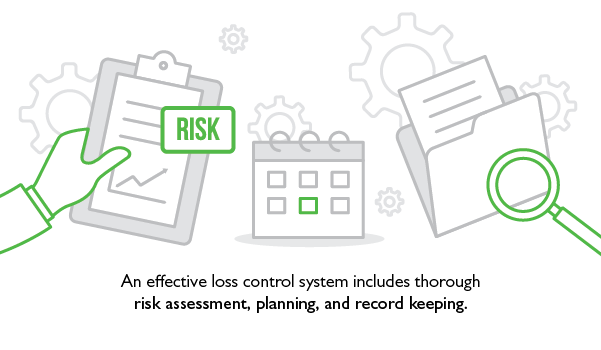According to the National Safety Council, a workplace injury occurs every seven seconds in America. What steps are you taking to keep your employees safe?
Workplace safety is a necessity for all businesses, regardless of how big or small. Employers sometimes get so focused on productivity that they undervalue the importance of solid safety measures for their employees. This can lead to injuries, illnesses, and damaged property, which can turn into insurance claims and lawsuits.
Loss control involves creating and implementing systems that are designed to make workplaces safer through evaluation, training, and monitoring. Some companies have internal risk managers, while others outsource to third-party loss control services.

Benefits of an effective loss control system
In order to run your business safely and smoothly, you need a well-implemented loss control strategy that will protect your employees and other assets. The cost of planning and executing this strategy could be far less than paying for the legal fees that can result from a workplace injury, or the cost of replacing equipment that breaks on the job.
One of the main reasons why companies create loss control systems is to reduce the cost of their business insurance premiums. With a risk management policy in place, your insurer will view your company as less of a liability, and therefore offer cheaper monthly premiums for coverage, allowing you to put more money toward growing your business. Oftentimes, insurance companies will provide policyholders with guidance and resources to help make their operations safer
Maintaining a safe working environment can also reduce employee turnover, minimize disruptions to productivity, and keep expensive inventory in good condition.
Here are three stages of loss control:
1. Risk assessment
This process involves one or more individuals routinely surveying work areas for potential hazards. Some of the aspects they pay attention to include, but are not limited to:
- Cleanliness of the workplace.
- How inventory is stored.
- Age and condition of equipment and machinery.
- Responsibilities of different employees.
- Lighting and temperature.
When a potential or existing hazard is discovered, the assessor will write a report and send it up the corporate ladder, so the process of minimizing risk can begin.
For example, let’s say you own a restaurant and you recently put together a safety committee to look out for any issues. After doing a thorough evaluation of your restaurant, they target the freezer as a concern, since the floor is frequently wet and slippery, which means someone could fall and injure themselves while in there.
2. Planning and prevention
This stage involves creating and implementing plans to eliminate hazards that were discovered during risk assessment. It starts by writing out a list of improvements that need to be made, then mapping out the steps that need to be taken to make sure those changes happen. Communication is key when implementing new strategies.
Whether it’s through email or a company-wide meeting, your team needs to be aware of the changes being made. And if they have questions or concerns, your safety committee should be ready and willing to assist.
3. Record keeping
Documentation is an essential part of loss control, especially when it comes to defending your company against employee lawsuits. Any safety updates must be recorded and filed so that they can be referenced later. It’s also imperative for all employees to have their own copy of your company’s safety policy, and that they agree to it before getting hired.
There are many types of business insurance coverage options available. Experienced commercial insurance agents, like those at Bank Midwest Insurance, can help evaluate risk levels for all kinds of businesses and recommend which policies best fit their needs.
To learn more about business insurance or loss control strategies, reach out to a local insurance professional at Bank Midwest Insurance today!
SOURCES:
https://www.investopedia.com/terms/i/insurance-loss-control.asp
https://www.osha.gov/shpguidelines/hazard-prevention.html
https://www.nsc.org/work-safety/tools-resources/infographics/workplace-injuries
https://www.safeopedia.com/definition/409/loss-control-health-safety-and-environment
